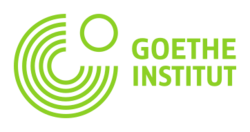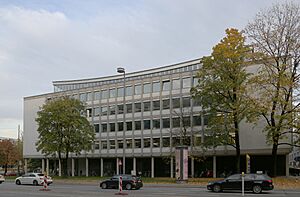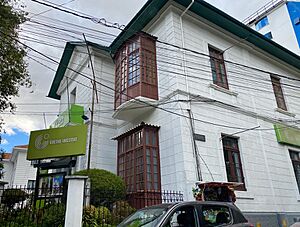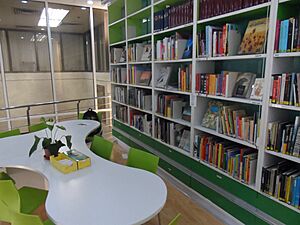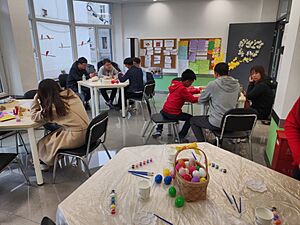Goethe-Institut facts for kids
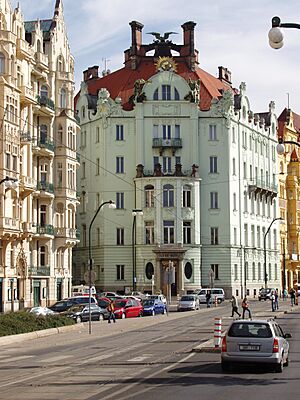
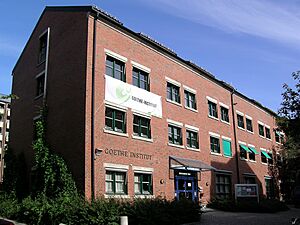
The Goethe-Institut (also known as GI) is a special German organization. It works all over the world, with more than 150 centers in 99 countries. Its main goal is to help people learn the German language and to share German culture with others. It also helps different countries connect through cultural exchange.
About 246,000 people take German language courses at the Goethe-Institut each year. The institute is named after a famous German poet and statesman, Johann Wolfgang von Goethe. It is an independent, non-profit organization.
The Goethe-Institut shares information about Germany. This includes details on German culture, society, and current events. They also promote German films, music, theater, and books. For over 60 years, their cultural centers, libraries, and language schools have been important for Germany's cultural and educational work worldwide.
The institute works with many partners. These include public and private cultural groups, German states, and local governments. A large part of the Goethe-Institut's money comes from the German Foreign Office. They also get money from their own activities and from sponsors.
Contents
- Exploring the History of the Goethe-Institut
- How the Goethe-Institut Works
- Goethe-Institut Locations Around the World
- Learning German from Anywhere: Distance Education
- German Language Exams and Levels
- Awards and Special Programs
- Famous People Who Studied at the Goethe-Institut
- Awards and Special Recognition
- See also
Exploring the History of the Goethe-Institut
The Goethe-Institut has a rich history of promoting German culture. It has grown and changed over the years to become the global organization it is today.
Key Milestones in the Institute's Journey
- 1951: The German government created the new Goethe-Institut. It replaced an older organization called the Deutsche Akademie.
- 1952: The very first Goethe-Institut opened its doors in Athens, Greece.
- 1953: The first German language classes started in Bad Reichenhall, Germany. More learning centers opened in small, pretty towns like Murnau and Kochel. The first textbook, "Schulz-Griesbach," was used for lessons.
- 1953-1955: The Goethe-Institut took over teaching German and training teachers abroad. They also started offering cultural events.
- 1959-1960: The Goethe-Institut gradually took over all German cultural institutes in other countries.
- 1962: A new Goethe-Institut opened in Malaysia, with over 200 students.
- 1968: The institute started to include more social and political topics in its cultural programs. They also began to feature modern art.
- 1970: German politician Ralf Dahrendorf helped create new guidelines for cultural work abroad. This work became known as "the third pillar of German foreign policy."
- 1976: The German Foreign Office and the Goethe-Institut signed an agreement. This made the Goethe-Institut an independent cultural organization.
- 1980: The institute changed where its centers were located in Germany. They moved from small towns to larger cities and university towns.
- 1989-1990: The fall of the Berlin Wall was a big moment. In the 1990s, the Goethe-Institut focused on Eastern Europe, opening many new centers there.
- 2001: The Goethe-Institut joined with another cultural organization called Inter Nationes.
- 2004: The Goethe-Institut opened the first Western information center in Pyongyang, North Korea. It operated until 2009. The organization also went back to its original name, Goethe-Institut.
- 2005: The Goethe-Institut received the Prince of Asturias Prize from Spain.
- 2010: An Italian cartoonist named Bruno Bozzetto created a new cartoon film called "Va Bene" for the institute.
- 2014: A Goethe-Institut opened in Myanmar's capital, Yangon.
How the Goethe-Institut Works
The German government provides most of the money for the Goethe-Institut. The institute has about 1,000 employees. Its total budget is around 366 million euros. More than half of this money comes from fees for classes and exams.
The institute also offers special training and scholarships. These help students from other countries who want to become German language teachers.
Goethe-Institut Locations Around the World
The Goethe-Institut has centers in many countries. These locations help people learn German and experience German culture.
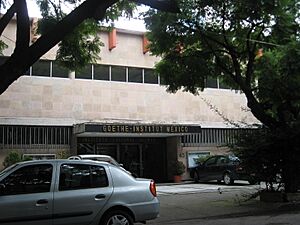
- In Africa, the first branches opened in Ghana, Togo, and Cameroon in 1961.
- The Goethe-Institut in Malaysia opened in 1962 in Kuala Lumpur.
- In Khartoum, Sudan, the Goethe-Institut opened in 1963.
- The Goethe-Institut in Bangladesh opened in Dhaka in 1961. It moved to its current location in 1967.
- In Lebanon, the Goethe-Institut was in Beirut. After the 2020 Beirut explosion, it moved to a new central location.
- The Goethe-Institut in Tehran, Iran, opened in 1958. It closed in 1981 due to diplomatic issues. However, some activities continued through the German embassy.
- In Pakistan, there are two branches. The Goethe-Institut Karachi is in an old bungalow. The Lahore center is called "Annemarie Schimmel Haus." It shares its space with the Alliance française Lahore and they often hold events together.
- In India, the institutes are called Max Mueller Bhavans. They are named after a German scholar, Max Müller. You can find them in Chennai, Coimbatore, Pune, Mumbai, New Delhi, Kolkata, and Bangalore.
- Indonesia has two Goethe-Institutes, in Jakarta and Bandung, and a Goethe-Zentrum in Surabaya.
- In Vietnam, there are two branches in Hanoi and Ho Chi Minh City.
- Kenya has a Goethe-Institut in Nairobi, also known as the German Cultural Centre.
- In the Philippines, the Goethe-Institut is in Makati, Metro Manila. It moved from its old location in Quezon City.
- The US has several Goethe-Institutes, including in New York and Los Angeles.
- In Nigeria, there is a learning center on Lagos Island.
- The United Kingdom has a main presence in London's South Kensington area. There are also offices in Glasgow and Kentish Town.
- In Greece, branches are in Athens and Thessaloniki.
- In Georgia, the Goethe-Institut is in the capital, Tbilisi.
- South Africa has two branches, one in Johannesburg and one in Cape Town.
- In the Czech Republic, the Goethe-Institut is in Prague.
Learning German from Anywhere: Distance Education
The Goethe-Institut offers courses where you can learn German from home. During the COVID-19 pandemic, when many people had to stay home, the Goethe-Institut started "blended learning" courses. These courses combine online learning with some in-person activities.
German Language Exams and Levels
The institute has created many exams for people learning German. These exams are for all levels, from beginner (A1) to advanced (C2). You can take these exams in Germany or in other countries. They follow the Common European Framework of Reference for Languages (CEFR), which is a standard for language testing in Europe. There is also a very advanced exam called the Großes Deutsches Sprachdiplom.
Here is a table showing the main Goethe-Institut exams and their levels:
| CEFR level | Goethe-Institut exam | Hours of study (45 minutes) needed |
|---|---|---|
| C2 | Goethe-Zertifikat C2: Großes Deutsches Sprachdiplom | 1,000 |
| C1 | Goethe-Zertifikat C1 (Prüfung Wirtschaftsdeutsch) | 800–1,000 (both) |
| B2 | Goethe-Zertifikat B2 (Zertifikat Deutsch für den Beruf) | 600–800 |
| B1 | Goethe-Zertifikat B1 (Zertifikat Deutsch) | 350–650 |
| A2 | Goethe-Zertifikat A2/ Fit In Deutsch 2 | 200–350 |
| A1 | Goethe-Zertifikat A1: Start Deutsch 1/Fit In Deutsch 1 | 80–200 |
In 2000, the Goethe-Institut helped start the Society for Academic Test Development. This group runs the TestDaF exams. These tests are for people who want to study at German universities, or for academics and scientists. You can take the TestDaF in Germany and in 65 other countries. For German language teachers, there is a "Green Diploma" to show their teaching skills.
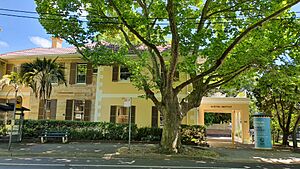
Awards and Special Programs
The Goethe-Institut gives out several awards and offers special programs. These celebrate achievements in German language and culture.
Recognizing Great Translations: Helen and Kurt Wolff Translator's Prize
The Helen and Kurt Wolff Translator's Prize is a well-known award. It is given each year for excellent translations of German books into English. There is also the Gutekunst Prize, which is for college students and young translators under 35 who have not yet published a book.
The Goethe Medal: Honoring Cultural Connections
Once a year, the Goethe-Institut gives out the Goethe Medal. This is an official award from Germany. It honors people from other countries who have done amazing work for the German language and for connecting cultures worldwide. The Goethe Medal started in 1954 and became an official German award in 1975.
Goethe-Institut Award for New Translation
The Society of Authors and the Goethe-Institut in London also give out an award every two years. It is called the Goethe-Institut Award for New Translation.
Villa Kamogawa: An Artist's Home in Japan
The Goethe-Institut Villa Kamogawa is a special place in Kyoto, Japan. It is a German institution that hosts artists from different fields. Artists can live and work there for a period of time. It opened in 2011. Villa Kamogawa is one of three major German artist residency programs abroad. The others are Villa Massimo in Rome and Villa Aurora in Los Angeles. Each year, it hosts three groups of four artists.
Famous People Who Studied at the Goethe-Institut
Many notable people have studied German at the Goethe-Institut.
- Avi Primor (born 1935), an Israeli writer and former diplomat.
- Jorge Mario Bergoglio (1936-2025), who became Pope Francis.
- Ian Kershaw (born 1943), an English historian.
- Sanmao (1943–1991), a Taiwanese author.
- Primo Levi (1919 – 1987), an Italian writer and Holocaust survivor.
- Renée Fleming (born 1959), an American opera singer.
- Auma Obama (born 1960), a journalist.
Awards and Special Recognition
The Goethe-Institut has received several important awards for its work.
- 2005: The Goethe-Institut, along with other cultural organizations like the Alliance française and the British Council, received the Prince of Asturias Award. This award recognized their achievements in communication and humanities.
- 2007: It received a special Konrad Duden Prize. This was for its work in promoting the German language.
See also
 In Spanish: Goethe-Institut para niños
In Spanish: Goethe-Institut para niños
- List of countries and territories where German is an official language
- German language in the United States
- German American Partnership Program
- Hallo aus Berlin
- Cultural Diplomacy
- Public diplomacy
- European Union National Institutes for Culture


